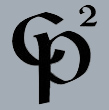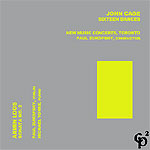
SIXTEEN DANCES
NEW MUSIC CONCERTS, TORONTO
PAUL ZUKOFSKY, conductor
ARMIN LOOS
SONATA NO. 2 FOR VIOLIN AND PIANO
PAUL ZUKOFSKY, violin
MICHAEL TORRE, piano

 |
JOHN CAGE SIXTEEN DANCES NEW MUSIC CONCERTS, TORONTO PAUL ZUKOFSKY, conductor ARMIN LOOS SONATA NO. 2 FOR VIOLIN AND PIANO PAUL ZUKOFSKY, violin MICHAEL TORRE, piano |
 |
JOHN CAGEIn the early 1950's John Cage began to turn his attention toward a new compositional domain. Previously, writing music for percussion and for prepared piano, Cage had concentrated on devising an aesthetic which would accommodate noises and silences as well as pitches. He had divided composition into four components: "structure," which concerned "the division of a whole into parts"; "materials," which were "the sounds and silences" of a composition; "method," which regulated the note-by-note choice of sounds; and "form," which reflected the underlying conception of a work, its overall morphology.1 At first Cage was much preoccupied with "structure" and "materials." He used a "square-root" principle to regulate "structure": a piece was divided into a number of units which were grouped into sections, and then each unit was divided into the same number of subunits grouped the same way. The "materials" of a piece were similarly limited-to a collection of percussion instruments, for example, or a group of preselected piano preparations. But although "materials" and "structure" were rather tightly controlled, "method" and "form" were essentially intuitive; they were guided not by a discipline but by Cage's personality. At the same time Cage was composing for dance, and when he and Merce Cunningham began collaborating regularly in the mid-1940's, they agreed to structure the dance and music together, in advance. Cunningham later recalled that "this use of a time structure allowed us to work separately, Cage not having to be with the dance except at structural points, and I was free to make the phrases and movements within the phrases vary their speeds and accents without reference to a musical beat, again only using the structural points as identification between us."2 The 16 Dances, first performed on 21 January 1951, were the most ambitious choreographic work to use this structural technique. In scope and content they recalled Cage's musical Sonatas and Interludes (1946-1948): but the 16 Dances also anticipated techniques to come, as Cunningham has explained: The 16 Dances . . . was a long piece intended to fill an evening. It was also the first time the use of chance operations entered into the compositional method. The choreography was concerned with expressive behavior, in this case the nine permanent emotions of Indian classical aesthetics, four light and four dark with tranquility the ninth and pervading one. The structure for the piece was to have each of the dances involved with a specific emotion followed by an interlude. Although the order was to alternate light and dark, it didn't seem to matter whether Sorrow or Fear came first, so I tossed a coin. And also in the interlude after Fear, number XIV, I used charts of separated movements for material for each of the four dancers, and let chance operations decide the continuity.3 Cunningham's choices yielded the following form for the Dances: In the other movements, however, Cage used a different "method," which in its effects anticipated chance techniques. Before beginning, Cage chose a gamut of 64 sounds and short gestures, which he arranged in an 8x8 chart, with each square containing a single event. To increase diversity, Cage altered his "materials" as he worked; after each pair of dances he replaced eight elements on his chart with new ones. These gamuts served somewhat like a prepared piano; but instead of composing with them intuitively, Cage used systematic moves on the chart akin to the moves of pieces on a chessboard. Thus the overall sequence would be unpredictable, although events located near each other on the chart would tend to occur together, producing some recurring patterns. And because the "method" would be applied consistently throughout each movement, the sections would no longer be differentiated; the movements composed this way would be heard as a single continuity. However, the Dances contained two sorts of choreography; and although Cage's new "method" suited the abstract interludes, the expressionistic solos required something different. For these Cage limited his "material" to the sounds which he judged best suited the subject; in addition, he altered density, dynamics, and other details as needed. Thus movement III, for example, expresses "humor" by means of extreme dynamic and timbral contrasts; while movement IX, the "odious," is pervaded by finicky ostinati. The structure of the 16 Dances also reflects Cage's increasing concern with social issues: the individualistic expressionism of the solos is contrasted with the collective consistency of the ensembles. And just as the individual and the collective are reconciled in the dance's closing quartet, in which an emotion ("tranquility") is, for the only time, expressed by the full ensemble, so too are the compositional techniques ultimately integrated: in the final movement a tranquil ostinato, composed intuitively, is overlaid with an everchanging sequence of sounds derived from the charts. Together with the Concerto for Prepared Piano and Orchestra, the 16 Dances mark the beginning of both Cage's exploration of social questions in music and his use of chance techniques. Shortly after their completion, Cage explained privately that "by making moves on the charts I freed myself from what I had thought to be freedom, [but] which was only [the] accretion of habits and taste."4 The paradox at the heart of this sentence-that in discipline alone is there freedom-has remained the core of Cage's practice ever since. William Brooks 1 John Cage, "Composition as Process," in Silence (Middletown, Connecticut: Wesleyan University Press, 1962), p. 18. Performers: Robert Aitken, flute; Otto Armin, violin; Peter Schenkman, cello; James Spragg, trumpet; Marc Widner, piano; Members of THE NEXUS PERCUSSION ENSEMBLE: Robert Becker, Robin Engelman, Russell Hartenberger and John Wyre; Paul Zukofsky, guest conductor
|
||||||||||||||||||||||||||||||||||||||||||||||||
| TRACK LISTING |
|
| John Cage: SIXTEEN DANCES |
|
| 1. I | (1:43) |
| 2. II | (4:50) |
| 3. III | (2:17) |
| 4. IV | (2:52) |
| 5. V | (2:29) |
| 6. VI | (2:19) |
| 7. VII | (3:06) |
| 8. VIII | (3:36) |
| 9. IX | (3:15) |
| 10. X | (2:25) |
| 11. XI | (2:41) |
| 12. XII | (2:19) |
| 13. XIII | (1:42) |
| 14. XIV | (6:29) |
| 15. XV | (4:51) |
| 16. XVI | (5:49) |
Time = 52:38 NEW MUSIC CONCERTS, TORONTO; CONDUCTED BY PAUL ZUKOFSKY A co-production with Canadian Broadcasting Corporation / Société Radio-Canada and NEW MUSIC CONCERTS, Toronto. |
|
Armin Loos: SONATA NO. 2 FOR VIOLIN AND PIANO |
|
| 17. Largo | (5:11) |
| 18. Vivace | (6:10) |
| 19. Larghissimo espressivo | (3:22) |
Time = 14:48 DDD PAUL ZUKOFSKY, violin MICHAEL TORRE, piano TOTAL TIME = 67:28 |
|
John Cage: (1912-1992) SIXTEEN DANCES
Publisher: C.F. Peters Corporation
Recorded at Walter Hall, University of Toronto, Canada, January 31, 1982.
Producer: David Jaeger
Recording Engineer: Kenneth Barnes
Editor: Joanna Nickrenz (Elite Productions)
Mastering: Robert C. Ludwig (Masterdisk Corp.)
This recording was originally released as an LP (CP2/15) and was a co-production with Canadian Broadcasting Corporation / Sociètè Radio-Canada and NEW MUSIC CONCERTS, Toronto.
Library of Congress Card Catalog No. 84-743251
1984 Musical Observations, Inc.
The original release was supported in part by public funds from the New York State Council on the Arts.
The generous support of Betty Freeman is gratefully acknowledged.
Armin Loos: (1904-1971) SONATA NO. 2
Copyright: Musical Observations, Inc.
Recorded March 1, 1995 at Master Sound Astoria, Astoria, NY
Produced and engineered by Paul Zinman
Assistant engineer: David Merrill
Hamburg Steinway provided by Mary Schwendeman Concert Service
CP2112
© 2004 Musical Observations, Inc.
Warning: Copyright subsists in all recordings issued
under this label.